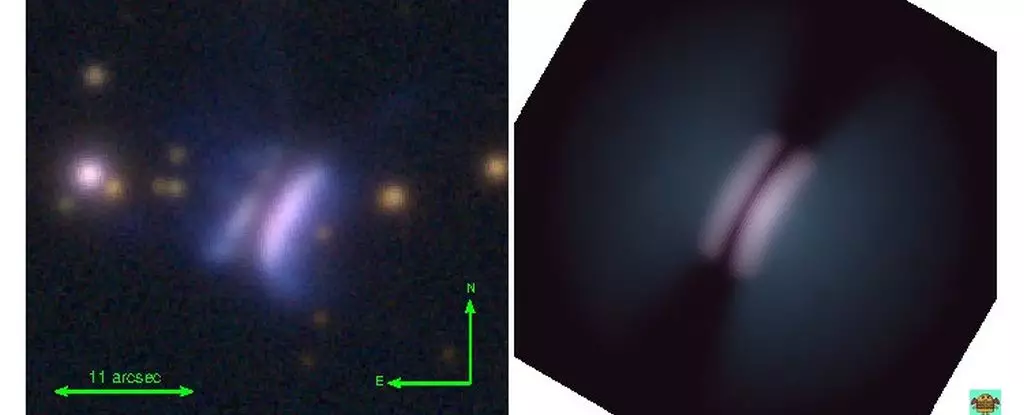The vastness of space never fails to surprise astronomers, as it reveals new wonders and mysteries that continue to baffle scientists. Among these cosmic wonders, a recent discovery of an object in the Milky Way by a team led by Ciprian Berghea has garnered attention. Dubbed “Dracula’s Chivito,” this object resembles the famous meat-laden sandwich from Uruguay. However, in reality, Dracula’s Chivito is a newborn star enveloped by a dense disk of dust and gas. This peculiar object, along with a similar one called Gomez’s Hamburger, presents an intriguing enigma for scientists to unravel. These isolated baby stars could hold the key to understanding a rare class of stellar formations that exist in the seemingly empty reaches of space.
Dracula’s Chivito, located roughly 980 light-years away, shares a striking resemblance to its predecessor, Gomez’s Hamburger. Both stars are positioned in a manner that the disk of dust and gas intersects the star’s light, just like the filling in a sandwich. These unique configurations provide an unconventional glimpse into the process of star formation, deviating from the commonly observed stellar nurseries rich in star-forming materials. The enigmatic nature of these objects has motivated scientists to investigate further, shedding light on their origins and the mechanisms that brought them into existence.
Scientists have acquired considerable knowledge about the birth of stars through radio observations over the years. The life of a star begins within a dense clump of molecular gas that collapses under the force of gravity, laying the foundation for a nascent star. As this protostar undergoes spin and growth, the surrounding material organizes into a disk, swirling around it and fueling its development. However, the absence of association with nearby star-forming regions or clusters raises questions about Dracula’s Chivito and Gomez’s Hamburger, setting them apart in their enigmatic solitude.
Examining the peculiar attributes of Dracula’s Chivito, Berghea and the team discovered that the central star is most likely a hot Herbig Ae-type star, burning at temperatures of approximately 8,000 Kelvin. The disk surrounding the star extends to a radius of about 1,650 astronomical units, containing material with a mass equivalent to around 0.2 times that of our Sun. While sharing similarities with Gomez’s Hamburger, Dracula’s Chivito presents an additional fascinating feature: two protruding filaments resembling fangs, which led to its intriguing name. These filaments, according to the researchers, indicate the existence of a diminishing envelope around the star. This fading bubble of material offers insights into the star’s formation stage, as young stars typically emit powerful winds and jets that disperse excess material around them. Consequently, the presence of a thin envelope suggests that Dracula’s Chivito is still in its early stages of development.
The discovery of Dracula’s Chivito presents a newfound opportunity for scientists to study the vertical structure of the star formation process. By delving into the isolated nature of these baby stars, researchers hope to unravel the mechanism behind their existence in the darkness of space. While these objects might be rare, there is a possibility that isolated baby stars are more abundant than previously believed. Discovering more instances of these cosmic loners could unlock the answers to the intriguing questions that surround their birth and presence in such desolate regions.
In the vastness of space, where stars and galaxies seem to dominate the scenery, the emergence of Dracula’s Chivito and its counterpart Gomez’s Hamburger serves as a reminder of the universe’s capacity for surprise. These isolated baby stars, floating in seemingly empty space, present an exciting mystery that captivates scientists. As the cosmic snacks of the sky, they provide a unique perspective on the star formation process, defying conventional expectations. Through further exploration and analysis, researchers hope to shed light on the origins and characteristics of these enigmatic objects, unraveling the secrets that lie within the darkness of the cosmos.



Leave a Reply